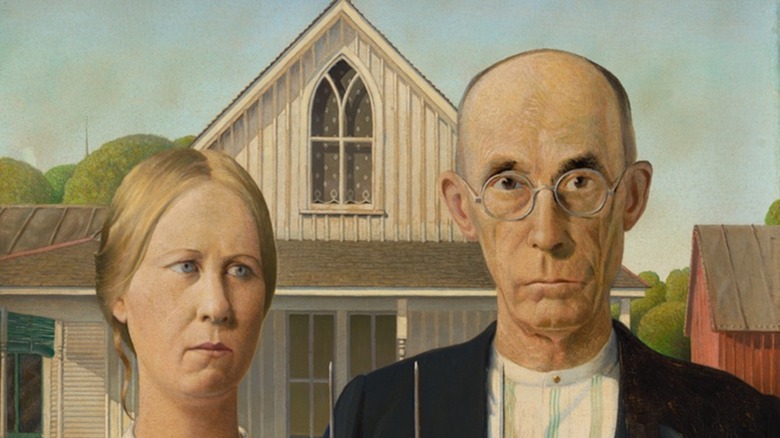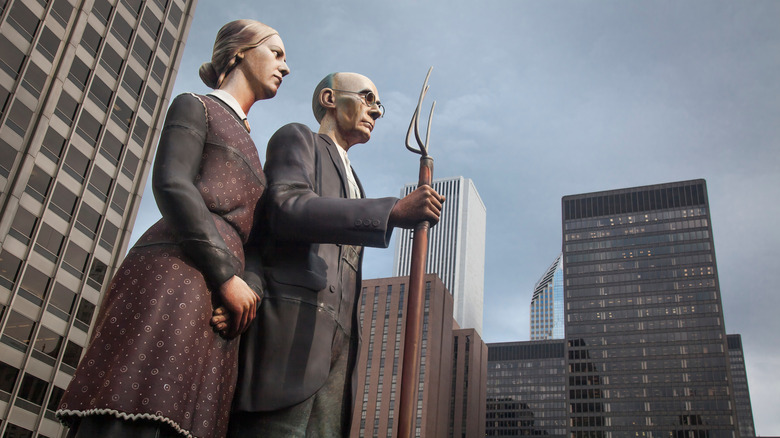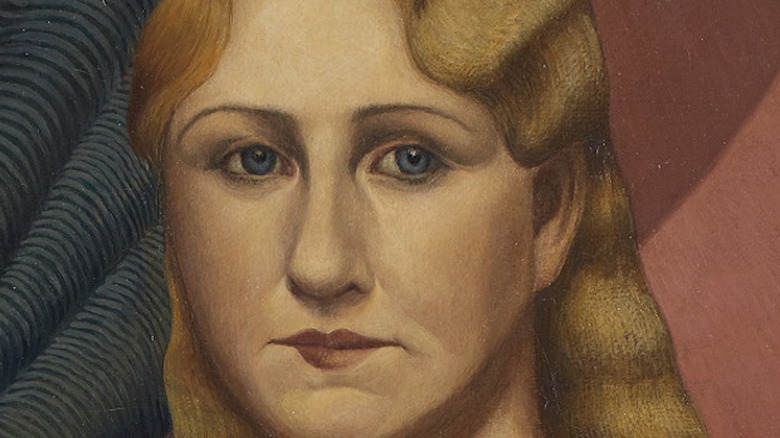The Weird Story Behind The Couple That Inspired The American Gothic Painting
"American Gothic" might be one of the most famous paintings in America, but how much do we really know about it? Painted in 1930 by Iowan artist Grant Wood, it depicts a woman and a man with a pitchfork in front of a farmhouse. Who were these two, and what did they represent?
Wood himself gave mixed answers to those questions. Initially, art critics — and writers like Gertrude Stein – viewed the painting as a satire of life in rural America. Other Iowans took this view, resenting the way they were portrayed as old-fashioned and stern. However, later on the painting was considered a tribute to American strength and resilience during the Great Depression. Wood seemed to say it was both at once, calling it satire and a "realistic statement" (via Mental Floss). He never explained the meaning of certain details of the painting that caused lots of speculation, like the pitchfork, the geraniums, and the window curtains.
Oddly, though he initially said the couple in the painting were a husband and wife, he later called them a father and daughter instead. Whatever they were in the painting, in real life, the two had no relationship to each other.
Byron McKeeby
The man in "American Gothic" wasn't a farmer at all — he was Grant Wood's dentist, Byron McKeeby. Wood admired McKeeby's strong hands and thought he would make the perfect model for the painting he had in mind. McKeeby initially declined, but he may have felt obligated to do it because Wood's love of sugar made him a frequent patient (via Mental Floss).
Wood promised to exaggerate McKeeby's features in the painting so he wouldn't be recognizable, but that didn't work out. As the painting became more and more famous, many people recognized McKeeby and asked him about it. He denied being the model for years, until finally admitted it in 1935. Later, in 1943, he actually went on a radio broadcast to talk about the painting. He said that his notoriety had slightly strained his friendship with Wood, but that no one could stay mad at Wood for long (via The Gazette).
Unlike in the painting, McKeeby was known to have a good sense of humor and stylish clothes. Interestingly, his grandson and namesake went on to be an artist himself.
Nan Wood Graham
The woman in the painting was actually Grant Wood's sister, Nan Wood Graham. She may be the reason Wood changed his answer about the relationship between the couple in the painting. Graham, in her early 30s, may not have wanted to be "married" to a 62-year-old man (via Mental Floss). According to The Washington Post, she defended her brother against people who said the woman's expression in the painting was too sour or severe and made Iowa women look bad. Graham was an artist herself, working with textiles, tissue, and painted glass.
About a year after "American Gothic," Wood painted another, more glamorous portrait of Graham with a fashionable hairstyle and clothes. According to Smithsonian Magazine, he told her it was the last time he would paint her, because her face had become too well known. Previously, while making "American Gothic," he had actually had her pose separately from McKeeby and the farmhouse, doing each part in different sessions. Graham's more famous portrait, "American Gothic," has hung in the Art Institute of Chicago since 1930.


